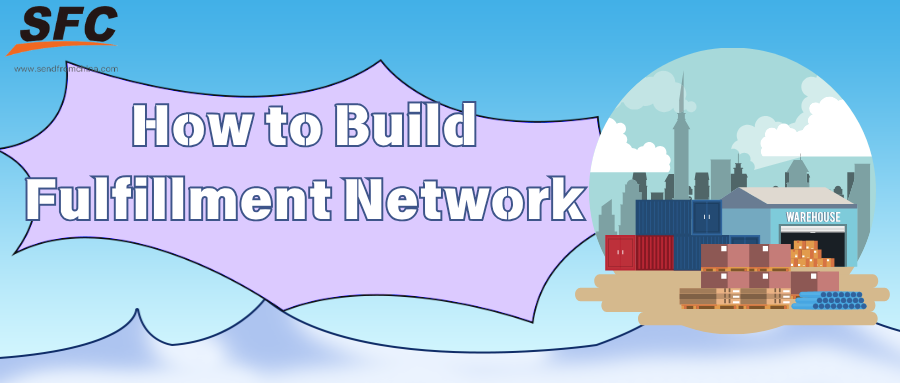Table of Contents
How to Build a Fulfillment Network for Ecommerce Business?
Time: May 29,2025 Author: SFC Source: www.sendfromchina.com
In today's digital marketplace, where consumers expect swift and seamless delivery, the backbone of a successful e-commerce business lies in its fulfillment network. This intricate system ensures that products move efficiently from warehouses to customers' doorsteps, meeting the high standards of speed and reliability that modern shoppers demand.Consider this: a study by Deloitte found that 85% of consumers prioritize delivery speed when choosing where to shop online. Moreover, businesses that optimize their fulfillment processes can reduce operational costs by up to 30%, according to McKinsey & Company. These statistics underscore the critical role that an effective fulfillment network plays in not only satisfying customers but also in enhancing a company's bottom line.
Building such a network involves more than just selecting a warehouse or partnering with a shipping provider. It requires a strategic approach that encompasses inventory management, technology integration, and logistics planning. Whether you're a burgeoning startup or an established retailer looking to scale, understanding how to construct and manage a robust fulfillment network is essential.

In this comprehensive guide, we'll delve into the fundamentals of e-commerce fulfillment networks, explore why they're indispensable for your business, and provide a step-by-step roadmap to building one that aligns with your specific needs. We'll also discuss common challenges and practical solutions to ensure your fulfillment operations are both efficient and resilient.
1. Understanding Ecommerce Fulfillment Network
In 2025, the efficiency of your fulfillment operations can make or break your business. An ecommerce fulfillment network is the backbone that ensures products move seamlessly from your inventory to your customer's doorstep.What Is an Ecommerce Fulfillment Network?
An ecommerce fulfillment network is a coordinated system comprising warehouses, distribution centers, inventory management systems, and logistics providers. This network handles the entire process of receiving, processing, and delivering online orders to customers. It encompasses several key components:- Order Management: Capturing and processing customer orders efficiently.
- Inventory Management: Monitoring stock levels to prevent overstocking or stockouts.
- Warehousing: Storing products in strategic locations to expedite delivery.
- Picking and Packing: Selecting the correct items and preparing them for shipment.
- Shipping and Delivery: Transporting orders to customers promptly.
- Returns Management: Handling product returns and restocking.
Each component plays a crucial role in ensuring that customers receive their orders accurately and on time.
The Importance of a Robust Fulfillment Network
In today's competitive ecommerce landscape, customer expectations are higher than ever. Fast, reliable, and transparent delivery services are no longer optional—they're essential. A well-structured fulfillment network enables businesses to:- Enhance Customer Satisfaction: Timely deliveries and efficient return processes build trust and encourage repeat business.
- Scale Operations: As your business grows, a scalable fulfillment network can handle increased order volumes without compromising service quality.
- Optimize Costs: Strategically located warehouses reduce shipping distances and shipping costs.
- Gain Competitive Advantage: Superior fulfillment services can differentiate your brand in a crowded market.
Real-World Applications
Major ecommerce players like Amazon and Shopify have set high standards in fulfillment efficiency. Amazon's extensive network of fulfillment centers allows for same-day or next-day delivery in many regions, setting customer expectations for rapid delivery. Similarly, Shopify's Fulfillment Network offers merchants access to a distributed network of warehouses, enabling faster shipping and improved customer experiences.2. Why You Need to Build a Fulfillment Network for Your E-commerce Business
Tthe efficiency and reliability of your fulfillment operations can significantly influence your business's success. Establishing a robust fulfillment network is not merely a logistical consideration; it's a strategic imperative that impacts customer satisfaction, operational efficiency, and scalability.
Meeting Elevated Customer Expectations
Today's consumers demand fast, accurate, and transparent delivery services. According to a report by WareIQ, efficient e-commerce fulfillment enhances customer satisfaction by ensuring timely deliveries and accurate order processing. A well-structured fulfillment network enables businesses to meet these heightened expectations consistently.Enhancing Operational Efficiency
A streamlined fulfillment network optimizes various operational aspects, from inventory management to order processing. By implementing advanced technologies and standardized procedures, businesses can reduce errors, minimize delays, and improve overall efficiency. This operational excellence not only reduces costs but also enhances the customer experience.Facilitating Business Scalability
As your e-commerce business grows, so does the complexity of your fulfillment needs. A scalable fulfillment network allows you to handle increased order volumes without compromising service quality. By leveraging third-party logistics providers or expanding your own fulfillment infrastructure, you can adapt to growth seamlessly.Gaining Competitive Advantage
In a crowded e-commerce market, differentiating your brand is crucial. A reliable fulfillment network enables you to offer faster shipping options, flexible delivery choices, and superior customer service. These capabilities can set your business apart from competitors and foster customer loyalty.Reducing Return Rates and Associated Costs
Efficient fulfillment processes contribute to accurate order fulfillment, which in turn reduces the likelihood of returns due to errors. By minimizing returns, businesses can lower associated costs and improve profitability. Additionally, a well-managed returns process enhances customer trust and satisfaction.Supporting Omnichannel Strategies
Modern consumers interact with brands across multiple channels, including online marketplaces, social media, and physical stores. A cohesive fulfillment network supports omnichannel strategies by ensuring consistent inventory management and order fulfillment across all platforms. This integration enhances the customer experience and streamlines operations.3. Key Components of a Fulfillment Network
A well-structured fulfillment network is the backbone of any successful e-commerce operation. Each component plays a pivotal role in ensuring that products move seamlessly from the point of origin to the customer's doorstep. Understanding these components is crucial for building an efficient and scalable fulfillment strategy.
Fulfillment Centers
Fulfillment centers are strategically located warehouses where products are stored, picked, packed, and shipped to customers. These centers are designed to handle large volumes of orders efficiently. By placing fulfillment centers closer to key customer regions, businesses can reduce shipping times and costs. For instance, Amazon's extensive network of fulfillment centers enables them to offer same-day or next-day delivery in many areas.Warehouse Management Systems (WMS)
A Warehouse Management System is a software solution that provides real-time visibility into inventory levels, order processing, and warehouse operations. It helps in optimizing storage space, managing stock movements, and ensuring accurate order fulfillment. Implementing a robust WMS can lead to increased efficiency and reduced operational costs.Inventory Management
Effective inventory management ensures that the right products are available at the right time. It involves tracking stock levels, forecasting demand, and replenishing inventory as needed. Poor inventory management can lead to stockouts or overstocking, both of which can negatively impact customer satisfaction and profitability.Order Management Systems (OMS)
An Order Management System centralizes order processing across various sales channels. It handles order entry, payment processing, customer communication, and order tracking. An efficient OMS ensures that orders are processed accurately and promptly, enhancing the overall customer experience.Picking and Packing Processes
Once an order is received, the picking process involves locating and retrieving the ordered items from the warehouse. The packing process then ensures that products are securely packaged for shipment. Implementing standardized picking and packing procedures can minimize errors and improve efficiency.Shipping and Carrier Integration
Integrating with reliable shipping carriers is essential for timely and cost-effective deliveries. Businesses should consider factors such as shipping rates, delivery times, and tracking capabilities when selecting carriers. Utilizing shipping software can automate label generation, rate comparison, and tracking updates.Returns Management
Handling returns efficiently is vital for maintaining customer trust and satisfaction. A streamlined returns process includes clear return policies, easy return initiation, and prompt refunds or exchanges. Implementing a returns management system can help in tracking returned items, analyzing return reasons, and improving product quality.Customer Service Integration
Customer service teams should have access to order and inventory information to assist customers effectively. Integrating customer service platforms with fulfillment systems enables representatives to provide accurate information on order status, shipping details, and return processes.Data Analytics and Reporting
Leveraging data analytics allows businesses to monitor key performance indicators (KPIs) such as order accuracy, fulfillment times, and inventory turnover. Regular reporting helps in identifying trends, forecasting demand, and making informed decisions to optimize the fulfillment network.Scalability and Flexibility
As businesses grow, their fulfillment needs evolve. A scalable and flexible fulfillment network can adapt to changing order volumes, product lines, and market demands. This adaptability ensures that the fulfillment operations continue to meet customer expectations without compromising efficiency.4. Building Your Fulfillment Network: Step-by-Step
Constructing an effective fulfillment network is a strategic endeavor that requires careful planning and execution. Below is a comprehensive, step-by-step guide to help you build a fulfillment network tailored to your e-commerce business needs.
Step 1: Analyze Your Business Requirements
Begin by assessing your current operations and future goals:- Order Volume: Determine your average and peak order volumes to understand capacity needs.
- Product Characteristics: Consider size, weight, fragility, and shelf life, as these factors influence storage and shipping requirements.
- Customer Demographics: Identify where your customers are located to optimize warehouse placement.
- Sales Channels: Evaluate all platforms you sell through (e.g., your website, marketplaces) to ensure integration compatibility.
Understanding these elements will inform decisions in subsequent steps.
Step 2: Choose the Appropriate Fulfillment Model
Select a fulfillment model that aligns with your business size, resources, and growth plans:- In-House Fulfillment: Managing storage, packing, and shipping internally offers control but requires significant investment in infrastructure and staff.
- Third-Party Logistics (3PL): Outsourcing to a 3PL provider can offer scalability and expertise, reducing the burden on your internal resources.
- Dropshipping: Suppliers handle fulfillment, minimizing overhead, but potentially reducing control over inventory and shipping times.
- Hybrid Approach: Combining elements of the above models can provide flexibility, such as using 3PLs for certain products while fulfilling others in-house.
Each model has its advantages and trade-offs; choose one that best fits your operational capabilities and customer expectations.
Step 3: Select Strategic Fulfillment Center Locations
Determine optimal locations for your fulfillment centers to enhance delivery speed and reduce shipping costs:- Proximity to Major Customer Bases: Position warehouses near high-order-density regions.
- Carrier Accessibility: Ensure locations have access to reliable shipping carriers and transportation infrastructure.
- Cost Considerations: Factor in regional labor costs, taxes, and real estate prices.
Utilizing data analytics can aid in identifying ideal locations that balance cost and service efficiency.
Step 4: Implement Robust Technology Solutions
Integrate technology to streamline operations and provide real-time visibility:- Warehouse Management System (WMS): Automates inventory tracking, order processing, and warehouse operations.
- Order Management System (OMS): Centralizes order information from multiple sales channels, facilitating efficient processing.
- Inventory Management Tools: Monitor stock levels, forecast demand, and automate reordering processes.
These systems should be scalable and compatible with your existing platforms to support growth and adaptability.
Step 5: Establish Reliable Carrier Partnerships
Partner with shipping carriers that align with your delivery requirements and customer expectations:- Service Levels: Evaluate carriers based on delivery speed, reliability, and coverage areas.
- Cost Efficiency: Negotiate rates and consider volume discounts to manage shipping expenses.
- Technology Integration: Choose carriers that offer tracking capabilities and integrate seamlessly with your systems.
Diversifying carriers can also mitigate risks associated with service disruptions.
Step 6: Develop a Comprehensive Returns Management Process
Design a returns process that is convenient for customers and efficient for your operations:- Clear Return Policies: Communicate return procedures and conditions transparently to customers.
- Automated Return Authorization: Implement systems that streamline return requests and approvals.
- Efficient Restocking Procedures: Establish protocols for inspecting, restocking, or disposing of returned items.
An effective returns process can enhance customer satisfaction and recover value from returned products.
Step 7: Monitor Performance and Continuously Optimize
Regularly assess your fulfillment network's performance to identify areas for improvement:- Key Performance Indicators (KPIs): Track metrics such as order accuracy, fulfillment time, and customer satisfaction.
- Customer Feedback: Solicit and analyze customer input to identify pain points and opportunities for enhancement.
- Process Audits: Conduct periodic reviews of operations to ensure compliance and efficiency.
Continuous improvement initiatives will help maintain a competitive edge and adapt to evolving market demands.
5. Challenges and Solutions in Building Fulfillment Network
Establishing a robust fulfillment network is essential for e-commerce success, but it's not without its hurdles. From inventory inaccuracies to scaling complexities, businesses often encounter obstacles that can impact customer satisfaction and operational efficiency. Understanding these challenges and implementing effective solutions is key to building a resilient fulfillment infrastructure.
Challenge 1: Inventory Inaccuracy
Problem: Inaccurate inventory data can lead to stockouts, overstocking, and order fulfillment errors, resulting in dissatisfied customers and lost sales.Solution: Implement real-time inventory management systems that provide accurate stock levels across all sales channels. Regularly conduct physical inventory audits to reconcile discrepancies and ensure data integrity. Utilizing barcode scanning and RFID technology can also enhance inventory tracking accuracy.
Challenge 2: Inefficient Order Processing
Problem: Manual order processing can be time-consuming and prone to errors, leading to delays and increased operational costs.Solution: Automate order processing workflows using Order Management Systems (OMS) that integrate with your e-commerce platforms. Automation reduces manual intervention, accelerates order fulfillment, and minimizes errors. Implementing batch processing and pick-and-pack optimization strategies can further enhance efficiency.
Challenge 3: High Shipping Costs
Problem: Shipping expenses can significantly impact profit margins, especially when offering free or expedited shipping options.Solution: Negotiate bulk shipping rates with carriers and consider partnering with third-party logistics providers that offer discounted rates. Strategically locate fulfillment centers closer to key customer regions to reduce shipping distances and costs. Utilize shipping software to compare carrier rates and select the most cost-effective options.
Challenge 4: Managing Returns Effectively
Problem: Handling product returns can be complex and costly, affecting inventory management and customer satisfaction.Solution: Develop a clear and customer-friendly return policy that outlines the process and conditions for returns. Implement a returns management system to track returned items, assess their condition, and restock or dispose of them appropriately. Analyzing return data can also provide insights into product quality and customer preferences.
Challenge 5: Scaling Fulfillment Operations
Problem: As your business grows, scaling fulfillment operations to meet increased demand can be challenging.Solution: Adopt scalable fulfillment solutions such as partnering with 3PLs that can accommodate fluctuating order volumes. Invest in modular warehouse systems and flexible staffing models to adapt to changing needs. Regularly review and optimize fulfillment processes to ensure they align with business growth.
Challenge 6: Technology Integration
Problem: Integrating various technologies across the fulfillment network can be complex, leading to data silos and inefficiencies.Solution: Choose fulfillment software and systems that offer seamless integration capabilities with your existing e-commerce platforms, inventory management systems, and customer relationship management tools. Utilize APIs and middleware solutions to facilitate data flow and ensure real-time visibility across all operations.
Challenge 7: Meeting Customer Expectations
Problem: Customers expect fast, accurate, and transparent order fulfillment, and failing to meet these expectations can harm your brand reputation.Solution: Implement real-time order tracking and proactive communication to keep customers informed throughout the fulfillment process. Ensure high order accuracy through quality control measures and employee training. Continuously gather customer feedback to identify areas for improvement and enhance the overall customer experience.
6. Conclusion
A fulfillment network isn't just a backend operation—it’s your customer experience engine. In a hyper-competitive market, fast and flawless delivery can be the difference between a one-time sale and a lifelong customer.By thoughtfully constructing a fulfillment network, aligning it with your business goals, and iterating based on real-time data, you can create a logistics machine that doesn’t just keep up with your growth—but accelerates it.
Remember: the right time to build is before you're overwhelmed. Start small, think big, and scale smart.
7. FAQs
1. What is the difference between 3PL and in-house fulfillment?
A 3PL (Third-Party Logistics) provider handles warehousing, packing, and shipping for you. In-house fulfillment means you manage all logistics yourself.2. How many fulfillment centers do I need?
Start with one or two based on your customer geography. Expand as your order volume increases or your delivery speed goals rise.3. What is the best software for managing fulfillment?
Popular choices include ShipBob, ShipStation, and Logiwa. The best tool depends on your scale and needs.4. How can I reduce shipping costs?
Use zone-based shipping strategies, negotiate with carriers, or split inventory across multiple locations to reduce distances.5. Do I need to handle returns myself?
Not necessarily. You can use reverse logistics partners or a 3PL with return processing capabilities. Post Views:1451
Post Views:1451
Copyright statement: The copyright of this article belongs to the original author. Please indicate the source for reprinting.
Previous Post
Inventory Days on Hand: What It Is, Why It Matters, and How to Calculate It
Next Post
How to Ship Books: Step-by-Step Guide for Safe, Cheap & Global Delivery
TAGS
Hot Research
Recent News
Get a Custom China Fulfillment Solution with FREE Storage for 30 Days
 Want to know about our services, fees or receive a custom quote?
Want to know about our services, fees or receive a custom quote?
 Please fill out the form on the right and we will get back to you within a business day.
Please fill out the form on the right and we will get back to you within a business day.
 The more information you provide, the better our initial response
will be.
The more information you provide, the better our initial response
will be.





 TAGS:
TAGS: